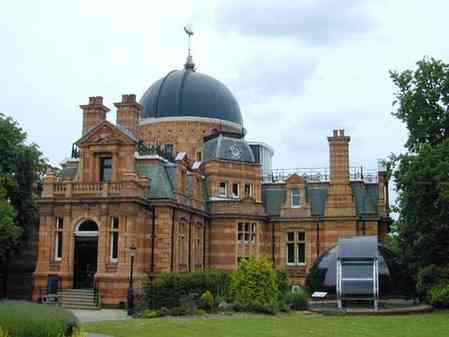格林尼治時間以英國首都倫敦市郊格林尼治天文臺命名,作為全球通用的時間參考標準已使用120多年。如今,這一以地球自轉為依據的“世界時”可能由以原子振蕩周期為依據的“原子時”徹底取代。上世紀70年代一項國際協議確定世界時和原子時兩種時間計量系統。世界時受地球自轉速度減緩影響,有一定誤差;原子時用原子能級躍遷振動頻率計時,1000萬年誤差1秒,相對精準。一些研究人員呼吁廢除時間計量系統的“雙軌制”,以原子時作為單一計時標準。50多名研究人員11月3日至4日在倫敦市郊開會,討論相關議題。國際電信聯盟定于明年1月在瑞士日內瓦表決是否以原子時替代世界時。不過,這一提議無疑會傷害英國人的“國家自豪感”。英國有官員表示,我們應該以地球自轉為依據,依照人們所感知的真實時間來計時。

 |
|
Royal Greenwich Observatory. |
For more than 120 years, Greenwich Mean Time (GMT) has been the international standard for timekeeping, but it is now under threat from a new definition of time itself based not on the rotation of the Earth, but on atomic clocks.
In January the International Telecommunication Union will meet in Geneva to vote on whether to adopt the new measure, despite protests from Britain.
The two-day meeting of about 50 experts at a country house north-west of London, under the aegis of the prestigious Royal Society, on Thursday and Friday will look at some of the issues involved.
Predictably the question has hurt Britain's national pride - particularly when the British believe their old rivals France are leading the push to change from GMT to the new time standard.
"We understand that in Britain they have a sense of loss for GMT," said Elisa Felicitas Arias, director of the time department at the France-based International Bureau of Weights and Measures (BIPM), which pushed for the change.
GMT is based on the passage of the Sun over the zero meridian line at the Greenwich Observatory in southeast London, and became the world standard for time at a conference in Washington in 1884.
France had lobbied for Paris Mean Time at the same conference.
In 1972 it was replaced in name by Universal Coordinated Time (UTC) but that essentially remained the same as GMT.
UTC is based on about 400 atomic clocks at laboratories around the world but then corrected with "leap seconds" to align itself with the Earth's rotational speed, which fluctuates.
Tiny variations
But the tiny variations between Earth speed and atomic speed have become a problem for GPS, the global positioning systems and mobile phone networks on which the modern world relies.
"These networks need to be synchronised to the millisecond," Dr Arias said.
"We are starting to have parallel definitions of time. Imagine a world where there were two or three definitions of a kilogram."
The meeting in London will look at the implications of abolishing the leap seconds and moving fully to atomic time.
That would see atomic time slowly diverge from GMT, by about one minute every 60 to 90 years, or by an hour every 600 years, and there would need to be "leap minutes" a couple of times a century to bring the two in line.
The proposal would then formally be voted on in Geneva.
Damaged pride
The potential loss of GMT has prompted soul searching in the British press, particularly at a time when the country is itself considering switching to British Summer Time, one hour ahead of GMT, on a permanent basis.
The Sunday Times said GMT had "symbolised Britain's role as a Victorian superpower" but that "just as that role has inexorably diminished, so GMT itself could in effect disappear".
British science minister David Willetts has opposed the plan, saying it has become more than just a scientific row.
"This is primarily a finely balanced scientific argument but I do detect undercurrents of nationalism," he said.
"Britain's position is that we should stick to real time as experienced by humans, which is based on the Earth's rotation, not atomic clocks.
"Without leap seconds we will lose contact with the reality of Earth's rotation. Eventually our midnight would happen at noon."
China meanwhile is said to oppose the change on the grounds that its astronomers want to retain Earth-rotation-based time.
相關閱讀
(Agencies)

(中國日報網英語點津 Helen )